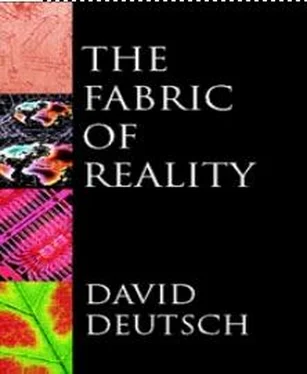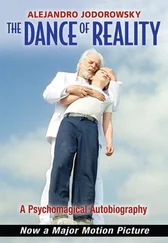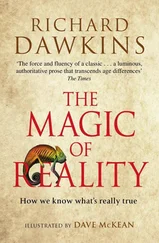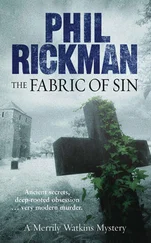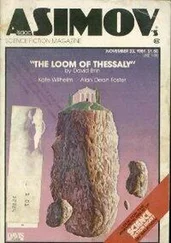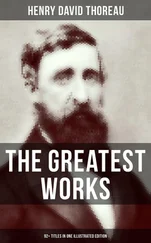David Deutch - The Fabric of Reality
Здесь есть возможность читать онлайн «David Deutch - The Fabric of Reality» весь текст электронной книги совершенно бесплатно (целиком полную версию без сокращений). В некоторых случаях можно слушать аудио, скачать через торрент в формате fb2 и присутствует краткое содержание. ISBN: , Жанр: Физика, Философия, на английском языке. Описание произведения, (предисловие) а так же отзывы посетителей доступны на портале библиотеки ЛибКат.
- Название:The Fabric of Reality
- Автор:
- Жанр:
- Год:неизвестен
- ISBN:0-7139-9061-9
- Рейтинг книги:4 / 5. Голосов: 2
-
Избранное:Добавить в избранное
- Отзывы:
-
Ваша оценка:
- 80
- 1
- 2
- 3
- 4
- 5
The Fabric of Reality: краткое содержание, описание и аннотация
Предлагаем к чтению аннотацию, описание, краткое содержание или предисловие (зависит от того, что написал сам автор книги «The Fabric of Reality»). Если вы не нашли необходимую информацию о книге — напишите в комментариях, мы постараемся отыскать её.
The Fabric of Reality — читать онлайн бесплатно полную книгу (весь текст) целиком
Ниже представлен текст книги, разбитый по страницам. Система сохранения места последней прочитанной страницы, позволяет с удобством читать онлайн бесплатно книгу «The Fabric of Reality», без необходимости каждый раз заново искать на чём Вы остановились. Поставьте закладку, и сможете в любой момент перейти на страницу, на которой закончили чтение.
Интервал:
Закладка:
This is hard to demonstrate with a torch alone, just because it is difficult to make very tiny filaments and very black surfaces. These practical difficulties mask the limits that fundamental physics imposes on the sharpness of shadows. Fortunately, the bending of light can also be demonstrated in a different way. Suppose that the light of a torch passes through two successive small holes in otherwise opaque screens, as shown in Figure 2.4, and that the emerging light falls on a third screen beyond. Our question now is this: if the experiment is repeated with ever smaller holes and with ever greater separation between the first and second screens, can one bring the umbra — the region of total darkness — ever closer, without limit, to the straight line through the centres of the two holes? Can the illuminated region between the second and third screens be confined to an arbitrarily narrow cone? In goldsmiths’ terminology, we are now asking something like ‘how “ductile” is light’ — how fine a thread can it be drawn into? Gold can be drawn into threads one ten-thousandth of a millimetre thick.
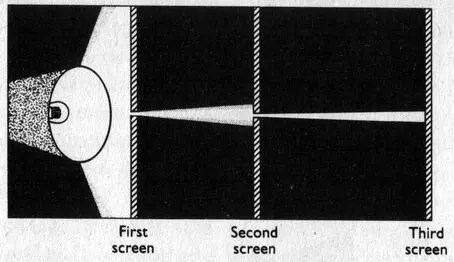
FIGURE 2.4 Making a narrow beam by passing light through two successive holes.
It turns out that light is not as ductile as gold! Long before the holes get as small as a ten-thousandth of a millimetre, in fact even with holes as large as a millimetre or so in diameter, the light begins noticeably to rebel. Instead of passing through the holes in straight lines, it refuses to be confined and spreads out after each hole. And as it spreads, it ‘frays’. The smaller the hole is, the more the light spreads out from its straight-line path. Intricate patterns of light and shadow appear. We no longer see simply a bright region and a dark region on the third screen, with a penumbra in between, but instead concentric rings of varying thickness and brightness. There is also colour, because white light consists of a mixture of photons of various colours, and each colour spreads and frays in a slightly different pattern. Figure 2.5 shows a typical pattern that might be formed on the third screen by white light that has passed through holes in the first two screens. Remember, there is nothing happening here but the casting of a shadow. Figure 2.5 is just the shadow that would be cast by the second screen in Figure 2.4. If light travelled only in straight lines, there would only be a tiny white dot (much smaller than the central bright spot in Figure 2.5), surrounded by a very narrow penumbra. Outside that there would be pure umbra — total darkness.
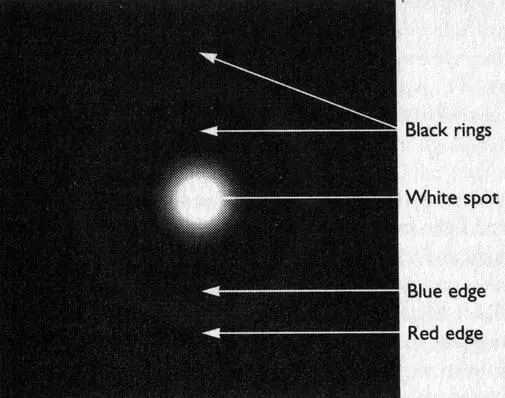
FIGURE 2.5 The pattern of light and shadow formed by white light after passing through a small circular hole.
Puzzling though it may be that light rays should bend when passing through small holes, it is not, I think, fundamentally disturbing. In any case, what matters for our present purposes is that it does bend. This means that shadows in general need not look like silhouettes of the objects that cast them. What is more, this is not just a matter of blurring, caused by penumbras. It turns out that an obstacle with an intricate pattern of holes can cast a shadow of an entirely different pattern.
Figure 2.6 shows, at roughly its actual size, a part of the pattern of shadows cast three metres from a pair of straight, parallel slits in an otherwise opaque barrier. The slits are one-fifth of a millimetre apart, and illuminated by a parallel-sided beam of pure red light from a laser on the other side of the barrier. Why laser light and not torchlight? Only because the precise shape of a shadow also depends on the colour of the light in which it is cast; white light, as produced by a torch, contains a mixture of all visible colours, so it can cast shadows with multicoloured fringes. Therefore in experiments about the precise shapes of shadows we are better off using light of a single colour. We could put a coloured filter (such as a pane of coloured glass) over the front of the torch, so that only light of that colour would get through. That would help, but filters are not all that discriminating. A better method is to use laser light, for lasers can be tuned very accurately to emit light of whatever colour we choose, with almost no other colour present.

FIGURE 2.6 The shadow cast by a barrier containing two straight, parallel slits.
If light travelled in straight lines, the pattern in Figure 2.6 would consist simply of a pair of bright bands one-fifth of a millimetre apart (too close to distinguish on this scale), with sharp edges and with the rest of the screen in shadow. But in reality the light bends in such a way as to make many bright bands and dark bands, and no sharp edges at all. If the slits are moved sideways, so long as they remain within the laser beam, the pattern also moves by the same amount. In this respect it behaves exactly like an ordinary large-scale shadow. Now, what sort of shadow is cast if we cut a second, identical pair of slits in the barrier, interleaved with the existing pair, so that we have four slits at intervals of one-tenth of a millimetre? We might expect the pattern to look almost exactly like Figure 2.6. After all, the first pair of slits, by itself, casts the shadows in Figure 2.6, and as I have just said, the second pair, by itself, would cast the same pattern, shifted about a tenth of a millimetre to the side — in almost the same place. We even know that light beams normally pass through each other unaffected. So the two pairs of slits together should give essentially the same pattern again, though twice as bright and slightly more blurred.
In reality, though, what happens is nothing like that. The real shadow of a barrier with four straight, parallel slits is shown in Figure 2.7(a). For comparison I have repeated, below it, the illustration of the two-slit pattern (Figure 2.7(b)). Clearly, the four-slit shadow is not a combination of two slightly displaced two-slit shadows, but has a new and more complicated pattern. In this pattern there are places, such as the point marked X, which are dark on the four-slit pattern, but bright on the two-slit pattern. These places were bright when there were two slits in the barrier, but went dark when we cut a second pair of slits for the light to pass through. Opening those slits has interfered with the light that was previously arriving at X.
So, adding two more light sources darkens the point X; removing them illuminates it again. How? One might imagine two photons heading towards X and bouncing off each other like billiard balls. Either photon alone would have hit X, but the two together interfere with each other so that they both end up elsewhere. I shall show in a moment that this explanation cannot be true. Nevertheless, the basic idea of it is inescapable: something must be coming through that second pair of slits to prevent the light from the first pair from reaching X. But what? We can find out with the help of some further experiments.

FIGURE 2.7 The shadows cast by a barrier containing (a) four and (b) two straight, parallel slits.
First, the four-slit pattern of Figure 2-7(a) appears only if all four slits are illuminated by the laser beam. If only two of them are illuminated, a two-slit pattern appears. If three are illuminated, a three-slit pattern appears, which looks different again. So whatever causes the interference is in the light beam. The two-slit pattern also reappears if two of the slits are filled by anything opaque, but not if they are filled by anything transparent. In other words, the interfering entity is obstructed by anything that obstructs light, even something as insubstantial as fog. But it can penetrate anything that allows light to pass, even something as impenetrable (to matter) as diamond. If complicated systems of mirrors and lenses are placed anywhere in the apparatus, so long as light can travel from each slit to a particular point on the screen, what will be observed at that point will be part of a four-slit pattern. If light from only two slits can reach a particular point, part of a two-slit pattern will be observed there, and so on.
Читать дальшеИнтервал:
Закладка:
Похожие книги на «The Fabric of Reality»
Представляем Вашему вниманию похожие книги на «The Fabric of Reality» списком для выбора. Мы отобрали схожую по названию и смыслу литературу в надежде предоставить читателям больше вариантов отыскать новые, интересные, ещё непрочитанные произведения.
Обсуждение, отзывы о книге «The Fabric of Reality» и просто собственные мнения читателей. Оставьте ваши комментарии, напишите, что Вы думаете о произведении, его смысле или главных героях. Укажите что конкретно понравилось, а что нет, и почему Вы так считаете.
